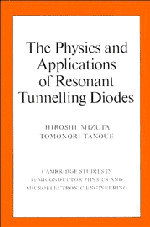Book contents
- Frontmatter
- Contents
- Preface
- 1 Introduction
- 2 Introduction to resonant tunnelling in semiconductor heterostructures
- 3 Scattering-assisted resonant tunnelling
- 4 Femtosecond dynamics and non-equilibrium distribution of electrons in resonant tunnelling diodes
- 5 High-speed and functional applications of resonant tunnelling diodes
- 6 Resonant tunnelling in low-dimensional double-barrier heterostructures
- Index
3 - Scattering-assisted resonant tunnelling
Published online by Cambridge University Press: 26 January 2010
- Frontmatter
- Contents
- Preface
- 1 Introduction
- 2 Introduction to resonant tunnelling in semiconductor heterostructures
- 3 Scattering-assisted resonant tunnelling
- 4 Femtosecond dynamics and non-equilibrium distribution of electrons in resonant tunnelling diodes
- 5 High-speed and functional applications of resonant tunnelling diodes
- 6 Resonant tunnelling in low-dimensional double-barrier heterostructures
- Index
Summary
In Section 2.6 we briefly studied the effects of electron scattering on resonant tunnelling which are inevitable in a real system operating at room temperature. The phenomenological Breit–Wigner formula was introduced to describe the incoherent aspect of the electron tunnelling which in general results in a broadening of the transmission peak and thus degraded current P/V ratios in RTDs. In this chapter we look in more detail at various scattering processes, both elastic and inelastic, which have been of great interest not only from a quantum transport physics point of view but also because of the possibility of controlling and even engineering these interactions in semiconductor microstructures. The inelastic longitudinal–optical (LO) phonon scattering, introduced in the preceding chapter, is the most influential process, with Г–X-intervalley scattering and impurity scattering also affecting the resonant tunnelling electrons. Section 3.1 describes the dominant electron–LO-phonon interactions. Both theoretical and experimental studies of a postresonant current peak are presented, which provide much information about the electron–phonon interactions in the quantum well. Section 3.2 then discusses the effects of the upper X-valley which become more significant in AlxGa1−xAs/GaAs systems with an Al mole fraction, x, higher than 0.45 since the energy of the X-valley then becomes lower than that of the Г-valley. Finally, in Section 3.3, we study elastic impurity scattering, which may be caused by residual background impurities or those diffused from the heavily doped contact regions.
- Type
- Chapter
- Information
- Publisher: Cambridge University PressPrint publication year: 1995
- 1
- Cited by



